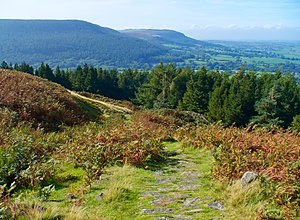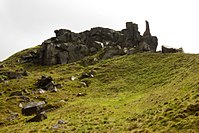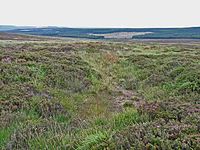Lyke Wake Walk

The Lyke Wake Walk is a forty-mile challenge walk across the highest and widest part of the North York Moors National Park in the North Riding of Yorkshire.
The walk has an associated club with a social structure, culture and rituals based on the walk and Christian and folklore traditions from the area through which it passes. The club's treatment of the route has a grim underlying theme, suggesting that it follows old coffin routes over the moors, and it certainly passes ancient burial mounds on the way: the name derives from a 'lyke', a corpse, and 'wake' for the watching over the deceased.
- Trailheads
- Scarth Wood Moor, near Osmotherley: 54°23’20"N, 1°16’23"W / SE459997
- The Raven Hall Hotel in Ravenscar: 54°23’49"N, 0°29’31"W / NZ981018
History
The idea of a walk originated from an article in the Dalesman magazine in August 1955. Its author, Bill Cowley, described a forty-mile walk across the North York Moors from east to west (or vice versa) on heather all the way except for when crossing one or two roads. Given the remoteness of the area, a lone walker might not encounter another during the one to two day journey. Cowley issued a challenge to see if anyone could walk from Scarth Wood Moor at the western extremity of the moors to Ravenscar on the coast, keeping on or close to the main watershed of the moorland, in a twenty-four-hour period. The first crossing was completed shortly afterwards on 1 and 2 October 1955.
Cowley was in the party that made the crossing in 23 hours and he wrote a book, Lyke Wake Walk,[1] which he kept up to date by frequent revision. The book ran to twelve editions in the author's lifetime and sold many thousands of copies.[2] It was revised in 2001 by Paul Sherwood.[3]
Cowley's idea developed over the years before he issued the challenge in 1955. He wrote a poem in 1935/6, Storming Along, describing traversing the moors and mentions a number of the walk's landmarks.[4] His early contributions to the Dalesman, appear in retrospect, to hint at the idea of the walk[5] drawing on his appreciation of the works of the archaeologist Frank Elgee,[6][7] antiquarian and folklore expert Canon John Christopher Atkinson[8] and author and rambler Alfred J. Brown.[9][10]
Route

The walk is usually done from west to east although it can be done in either direction. A successful crossing must be completed within 24 hours. There is no exact route but the Lyke Wake Club and its successor have rules regarding what can be considered a successful crossing. For record purposes the walk starts at its original departure point, the Ordnance Survey Trig point on Scarth Wood Moor, near Osmotherley, and finishes in the bar of the Raven Hall Hotel in Ravenscar. For practical purposes the acceptable end points are the Lyke Wake Stone adjacent to Sheep Wash car park at Osmotherley Reservoir at the western end and Beacon Howes car park where there is a second Lyke Wake Stone at the eastern end. Successful crossings must stick to the moorland summits as far as practicable and walkers straying into Eskdale are disqualified.
The route crosses the Stokesley-Helmsley road (B1257) between Point 842 (Clay Bank Top) and Point 503 (Orterley Lane end), the Whitby-Pickering road (A169) between Point 945 (Sil Howe) and Point 701 (near Saltergate) and the Scarborough-Whitby road (A171) between Point 538 (Evan Howe) and Point 579 (Falcon Inn).[11]

The original route began at Scarth Wood Moor trig point, followed the Alum/Jet Miners Track from Live Moor to Hasty Bank, then to Smuggler's Trod, Bloworth, Ironstone Railway, Esklets, White Cross (Fat Betty), Shunner Howe, Hamer, Blue Man-i'-th'-Moss, Wheeldale Stepping Stones, Fen House, Tom Cross Rigg, Snod Hill, Lilla Howe, Jugger Howe ravine, Helwath, Pye Howe Rigg, to Ravenscar (Raven Hall Hotel). This route is no longer possible as a section is within the Ministry of Defence controlled area at RAF Fylingdales Early Warning Radar Station.

Most crossings now follow the classic route,[12] a variation of the original. It begins at Scarth Wood Moor trig point or the western Lyke Wake Stone in Sheepwash car park, follows the summit track from Live Moor over Carlton Moor, Cringle Moor, Cold Moor and Hasty Bank, Smuggler's Trod, Bloworth, Ironstone Railway, Esklets or South Flat Howe or Lion Inn, White Cross (Fat Betty), Shunner Howe, Hamer, Blue Man-i'-th'-Moss, Wheeldale Stepping Stones, Fen Bogs, Eller Beck, Lilla Howe, Jugger Howe ravine, Stony Marl Moor, to the eastern Lyke Wake Stone at Beacon Howes or Ravenscar. A summary description of the classic route with photographs is described by Richard Gilbert in his book, The Big Walks[13] and a guidebook is available.[14] A detailed illustrated description of the western half of the walk is given in Alfred Wainwright's A Coast to Coast Walk.[15]
Most crossings are done west to east. The original challenge, crossing towards the sea in an easterly direction is thought to be easier because of the prevailing wind from the west[16] making it easier to walk with the wind on one's back and with the heather lying away from the walker. On a west to east crossing, the major ascents and descents occur in the first ten miles when the walker is relatively fresh. A traverse of the Lyke Wake Walk route is referred to as a crossing and the act of participating in the walk is known as dirging.
In the first few years, the walk followed a difficult route requiring endeavour and physical endurance as there was no track over most of its length. From the mid-1970s the walk was re-thought because the numbers of people attempting it had, in places, eroded the ground surface,[17][18][19] and disturbance to game birds, sheep and wildlife by walkers and their support parties at all times of day and night, particularly in Osmotherley, Ravenscar and at remote farms. Footpath erosion was compounded by the walk sharing long stretches of its route with the Cleveland Way and Wainwright's Coast to Coast Walk. Other users, some legal, some illegal, including mountain bikes, motor cycles, quad bikes and agricultural and moorland management vehicles exacerbated the problem. Alternative routes are possible and the walk club works with the National Park authority to try to limit environmental damage.
The Ordnance Survey no longer marks the walk route on maps at the recommendation of the National Park Authority, as a measure to discourage large numbers undertaking a crossing and the walk was not mentioned in National Park Authority publication for a number of years.[20]

Other long-distance walks in the area
Alternative challenge walks and trails include the Hambleton Hobble, the Shepherd's Round, the White Rose Walk, the Lyke Wake Way, the Monk's Trod, the Rail Trail, Hambleton Drove Road, the Crosses Walk and the long distance trails. A walk from west to east across the North York Moors around ten miles south of the Lyke Wake Walk from Gormire Lake to Cloughton Wyke termed, in a play on words, the Lake Wyke Walk has been suggested.[21]
The Lyke Wake Way is a non-challenge alternative from Osmotherley to Ravenscar on public rights of way via locations where accommodation and other facilities are available. It entails fifty to sixty miles of walking depending on the route taken and can be completed over two or three days.

Alfred Wainwright suggested the walk could form an acceptable finish to his Coast to Coast Walk but did not specify if he recommends doing the forty miles in a single push. There is no record of Wainwright completing the walk. There are no constraints on doing the walk in a more leisurely manner and a guide to doing the walk over four days has been published.[22]
Lyke Wake Clubs
The first Lyke Wake Club was formed immediately on completion of the first crossing. Those completing the first crossing were its foundation members.[23][24][25]
The walk takes its name from the "Lyke-Wake Dirge", probably Yorkshire's oldest surviving dialect verse,[26] which is about watching over the wake of the corpse (lyke).[27] Cowley proposed linking the walk and the dirge before the first crossing had been completed.[28] The song tells of the soul's passage through the afterlife.[29] The walk does not follow a corpse road, although it has been suggested it does,[30][31][32][33] though there is no historical or archaeological evidence for it.[34][35] The physical challenge, possibility of bad weather and difficult conditions make the dirge an appropriate club song.
The club established its own culture and developed traditions based around the dirge, aspects of Cleveland history, superstitions and folklore, and rituals associated with suffering, death, funerals and the after-life that are broadly Yorkshire in character, with an acknowledgement of local folklore and the pagan forebears who originally inhabited the moorlands. Club meetings were termed "wakes" and the club badge was coffin shaped and decorated with the Ordnance Survey symbol for a tumulus (burial mound), many of which are found along the route. Many crossing reports are humorous and in various forms including prose, poetry,[36] maps, post-mortem reports, last wills and testaments, plays, etc., some of which are quoted in the many editions of Cowley's Lyke Wake Walk book and in a separate volume devoted to literature and artwork contributed by members.[37] Female members are termed "Witches", males are "Dirgers".

The walk emerged when outdoor challenges and sponsored fund-raising events were becoming a feature of national life.[38] It became popular and was considered a "rite of passage" for outdoor enthusiasts in Yorkshire in particular and across the north of England. It became a challenge for fundraisers for good causes. Reliable estimates, based on club records, put the number of people having completed a crossing at more than 250,000. Possibly more than 30,000 made more than one crossing, a significant number have completed it more than ten times and a handful have made more than a hundred.
The walk's popularity owes much to Cowley's book which gives insights into the history, archaeology, geography, natural history, and folklore of the moors.[39] The book describes the club and its culture in a tongue-in-cheek humorous style. Its first edition contained a list of the successful crossings up to October 1958. The possibility of inclusion in future editions together with the use of quotes from some crossing reports became an incentive to those taking on the challenge and inspired correspondents to be inventive and "attain literary heights".
Outside links
- New Lyke Wake Club
- Old Lyke Wake walk site - still open
References
- ↑ Cowley, Bill (1959). Lyke Wake Walk: Forty Miles Across the North Yorkshire Moors (1st ed.). Skipton, Yorkshire: Dalesman Books.
- ↑ Cowley, Bill (1993). Lyke Wake Walk and the Lyke Wake Way (12th ed.). Skipton, Yorkshire: Dalesman Books. ISBN 1-85568-063-7.
- ↑ Paul, Sherwood (2001). Lyke Wake Walk. Skipton, Yorkshire: Dalesman Publishing. ISBN 1-85568-191-9.
- ↑ Cowley, Bill (1945). Tara Devi and Other Verses. India: Punjab Boy Scouts Association.
- ↑ "Obituary: Bill Cowley". The Guardian. 17 August 1994. SSN 0261-3077.
- ↑ Elgee, F. W. (1912). The Moorlands of North-East Yorkshire. London: Brown & Sons.
- ↑ Elgee, F. W. (1930). Early Man in North-East Yorkshire. Gloucester: John Bellows.
- ↑ Atkinson, John C. (1891). Forty years in a Moorland Parish: reminiscences and researches in Danby in Cleveland. London: Macmillan. Later editions: 1907, 1967 and 1983.
- ↑ Brown, Alfred J. (1952). Fair North Riding. London: Country Life.
- ↑ Brown, Alfred J. (1945). Striding Through Yorkshire. London: Country Life.
- ↑ Lyke Wake Club Newsletter, Summer 1971.
- ↑ Goodman, Jim (1997). The Lyke Wake Walk in Quarter Mile Steps. London: Minerva Press. ISBN 1-8610-6368-7.
- ↑ Wilson, Ken; Gilbert, Richard (1980). The Big Walks : Challenging Mountain Walks and Scrambles in the British Isles. London: Diadem Books. ISBN 0-906371-60-0.
- ↑ Smailes, Brian (2013). The Lyke Wake Walk Guide (4th ed.). South Yorkshire: Challenge Publications. ISBN 978-1-903568-70-5.
- ↑ Wainwright, A. (1973). A Coast to Coast Walk. Kendal, Westmorland: Westmorland Gazette.
- ↑ Redfern, Roger A. (1976). Walking in England. London: Robert Hale & Company. ISBN 0-7091-5483-6.
- ↑ Thackrah, Ian (1985). Yorkshire: York, Yorkshire Dales & North York Moors. Golden Hart Guides. London: Sidgwick & Jackson. ISBN 0-283-99203-4. https://archive.org/details/yorkshire00iant.
- ↑ Cleare, John (1988). Fifty Best Hill Walks of Britain. Exeter: Webb & Bower. ISBN 978-0-86350-142-5.
- ↑ Smailes, Brian (1994). The Novices Guide to Completing the Lyke Wake Walk. Barnsley: Challenge Publications. pp. Photographic Plates 3 & 4. ISBN 978-0-95269-001-6.
- ↑ Smith, Roland (1993). Explore Britain's National Parks. Basingstoke: Automobile Association. ISBN 0-7495-0683-0.
- ↑ "North York Moors ... Getting There From Holderness Road, Hull". http://www.thehumangenehome.com/#/page-3/4534886078.
- ↑ Collins, Martin; Dillon, Paddy (2011). The North York Moors: A Walking Guide. Milnthorpe: Cicerone Press. ISBN 978-1-85284-448-6.
- ↑ Cowley, Bill (1971). Lyke Wake Walk: Forty Miles Across the North Yorkshire Moors (5th ed.). Skipton, Yorkshire: Dalesman Books. ISBN 1-85568-063-7.
- ↑ Yorkshire Facts and Records (2nd ed.). Clapham, North Yorkshire: Dalesman Books. 1972. ISBN 0-85206-173-0.
- ↑ Joy, David, ed (1990). The Dalesman: A Celebration of 50 Years. London: Pelham Books. ISBN 0-7207-1969-0.
- ↑ Waddington-Feather, John (1970). Yorkshire Dialect. Clapham, North Yorkshire: Dalesman Publishing. ISBN 978-0-85206-046-9.
- ↑ Hillaby, John (1986). John Hillaby's Yorkshire: The Moors and Dales. London: Constable & Co.. ISBN 0-09-466910-4.
- ↑ Cowley, Bill (November 1955) The Dalesman.
- ↑ Colbeck, Maurice (1983). Yorkshire Moorlands. London: Batsford Ltd.. ISBN 0-7134-3803-7.
- ↑ Harding, Mike (1986). Walking the Dales. London: Michael Joseph Ltd. ISBN 0-7181-2701-3.
- ↑ Bathurst, David (2007). The Big Walks of Great Britain. Chichester: Summersdale Publishers. ISBN 1-84024-566-2.
- ↑ Else, David (1997). Walking in Britain. London: Lonely Planet Publications. ISBN 0-86442-478-7.
- ↑ Dent, R. (1994). "A Tribute to Bill Cowley". Transactions of the Yorkshire Dialect Society XVIII (XCIV).
- ↑ Parker, Mike (2011). The Wild Rover. London: HarperCollins Publishers. ISBN 978-0-00737-266-9.
- ↑ "Lyke Wake Walk". 2012. http://where2walk.co.uk/walking-challenges/lyke-wake-walk/.
- ↑ Chapman, Ian (2013). Lyke Wake Walk Crossing 1982. Ian Chapman.
- ↑ Cowley, Bill; Morgan, Phil (1979). Lyke Wake Lamentations. Skipton, Yorkshire: Dalesman Books. ISBN 0-85206-487-X.
- ↑ Spencer, Brian (1984). The Visitor's Guide to The North York Moors, York and the Yorkshire Coast. Ashbourne: Moorland Publishing. ISBN 0-86190-115-0. https://archive.org/details/visitorsguidetot00spen.
- ↑ "The Lyke Wake Walk". http://scoutguidehistoricalsociety.com/lykewake.htm.